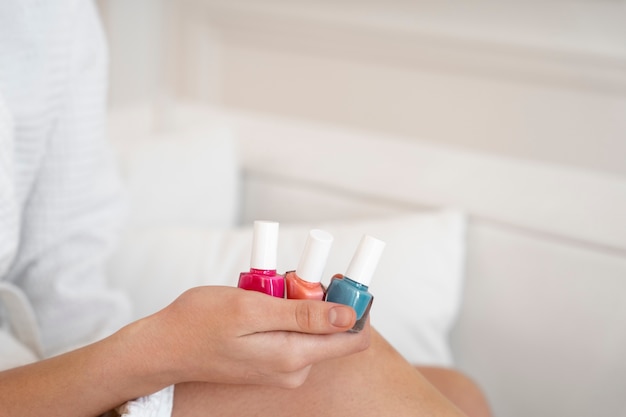
Did you know Americans spend an incredible $768 million a year on nail polish? But nails aren’t just about trendy colors and stylish designs; they’re a reflection of your overall health too. Changes in their appearance—like thickening or discoloration—could signal underlying health problems, including serious conditions like liver or kidney disease. Your nails tell a story about what’s going on inside your body.
### How Nails Reflect Your Health
Healthy nails generally grow about 3.5 millimeters per month, but this rate can vary based on your diet, medical conditions, medications, and even aging. Problems like swelling, changes in shape or thickness, brittleness, or discoloration shouldn’t be ignored. In some cases, these symptoms might point to issues like thyroid problems, diabetes, anemia, or even fungal infections. Dry, brittle nails could also be a sign of vitamin deficiencies or the environment, especially in areas with low humidity. If you notice anything unusual, it’s best to consult a dermatologist.
Interestingly, nail polish itself can play a role in nail health. For example, yellowing nails can come from wearing acrylic nails over time. Crumbly, thick, yellow nails may point to a fungal infection, while frequent splitting and cracking could be linked to health conditions like hypothyroidism.
### Why Are So Many Nails Unhealthy?
If you’ve struggled with nail health, you’re not alone. Countless people deal with nail problems, often caused by two primary culprits:
#### 1. Harsh Chemicals
In daily life, we’re exposed to all kinds of chemicals that wreak havoc on our nails. Household cleaners, like bathroom or laundry products, can strip your nails of their natural moisture. And while salon treatments like acrylic nails look gorgeous, they can be particularly damaging. From the chemicals used during application to the harsh removal process, they often leave nails weak and brittle.
#### 2. Excessive Water Exposure
It might sound surprising, but too much water can dry out your nails. Every time your nails are soaked and dry again, they lose moisture, which can lead to weakness and brittleness over time.
### Protecting and Reviving Unhealthy Nails
Preventing nail damage doesn’t have to be complicated. If your hands are often exposed to water or chemicals, consider wearing gloves to protect them. However, if your lifestyle makes this difficult, there’s another solution: shellac manicures.
#### Shellac: A Game-Changer for Nail Health
Shellac nails are sometimes called the “super polish,” and for good reason. Unlike many other options, shellac is gentle on your nails, free of harsh chemicals, and incredibly durable. Its application and removal processes avoid the painful sanding or filing associated with acrylic nails.
Shellac is a type of hybrid manicure that combines the best of both worlds—nail polish and gel. This long-lasting polish can stay chip-free for up to two weeks or even longer for some people. Plus, it’s quick-drying and doesn’t require touch-ups, making it a convenient choice for busy schedules.
But it does come with certain caveats. For instance, nail hygiene is crucial before applying shellac. If your nails or cuticles are unhealthy or damaged, shellac won’t be as effective. Additionally, the UV curing process used during application can lead to age spots if precautions like wearing sunscreen or gloves aren’t taken.
### Benefits and Limitations of Shellac
One of the major perks of shellac polish is its staying power. While traditional nail polish chips quickly, shellac provides a glossy, salon-fresh look for weeks with minimal maintenance. However, it does require careful removal, ideally with acetone and patience—no peeling or picking involved, as this could harm your natural nails.
For ongoing nail health, applying cuticle oil twice a day is a great habit. This not only keeps your nails hydrated but also nourishes the nail bed, ensuring your nails remain strong underneath your polish.
#### How Shellac Compares to Other Nail Treatments
Shellac is often confused with gel manicures, but there are key differences. While they both offer durability, shellac is thinner and feels more natural. It also avoids some of the harsher processes associated with acrylics or gel extensions. Plus, it’s free of common allergens like formaldehyde, toluene, and DBP, making it hypoallergenic for most users.
### Is Shellac Worth It?
For anyone looking for low-maintenance, long-lasting nail care, shellac is an excellent option. It’s especially ideal if you want polished nails without needing weekly touch-ups. Though slightly pricier than traditional manicures, its durability often makes the cost worth it.
Unlike regular nail polish, which takes hours to fully dry, shellac is ready to go as soon as the manicure is done. This makes it perfect for avoiding accidental smudging or damage immediately after application. Additionally, shellac doesn’t weaken nails like acrylics often do, making it a gentler option if applied correctly.
### Proper Removal and Aftercare
While shellac is durable, improper removal can be damaging. If you can’t make it to the salon, you can remove it at home by soaking your nails in acetone for 10-15 minutes. Just resist the urge to peel it off, as this can take layers of your natural nail with it.
For extra nail protection, apply lotion or cuticle oil regularly to keep dryness at bay. And don’t forget SPF if you’re worried about UV exposure during curing.
### Why Go Shellac?
Whether you’re a dishwashing pro or simply someone who wants a polished look without the regular upkeep, shellac offers a convenient solution. Its glossy finish, durability, and gentleness on natural nails make it a favorite for many. With proper care and occasional breaks to let your nails breathe, shellac can keep your hands looking stunning week after week.